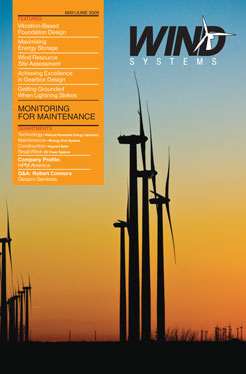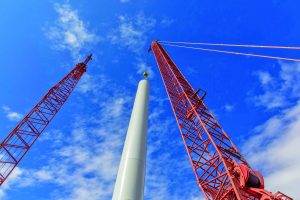As you know, the gearbox is a critical component of the wind turbine drivetrain. Should you encounter a problem with this unit, what should you do? Who can handle the repairs, what will they cost, and how long will it be down? All are valid questions, but one of the most important is whether the gear unit needs to be removed from the turbine at all.
Today’s megawatt-class gear units are designed to allow repair work uptower. As a matter of fact, service professionals are involved in the design process of a Winergy gearbox. Part of the service team’s responsibility is to ensure the ease of serviceability, design new tools, and develop procedures to exchange gears and bearings uptower. The serviceability of gear units should be a selection criterion for every turbine user, and one of the key questions asked during the turbine selection process.
After determining who will work on the gearbox, the next logical question to ask is how it will be repaired. What repair processes are being used, how is the unit being disassembled, how will damage be avoided during disassembly, and how will the parts be stored until reassembly? Like all major suppliers, Winergy has developed both assembly and disassembly instructions. This addresses these questions while reassuring the customer that the unit will be tested as well as approved. Don’t forget to make sure these reports are comprehensible, however. A good disassembly and inspection report with a drawing of the gear unit in question and a detailed description of the findings, as well as illuminated and focused pictures, should be the norm.
And what about the different types of parts, both new and reworked, that are going to be used? All gears are not made equally. The gear unit OEM has drawings, specifications, and more documents to insure that every part is made to the same standard as those made for a new gear unit, and new parts cannot be fashioned accurately without the original dimensions.
The same gear-cutting machines, heat-treat ovens, and grinding machines are used for new production and service parts alike. Both parts are sometimes made side by side, with the manufacturer determining only then which will be used in the new gear units, with the others designated for repairs. Gear units are manufactured to highly precise DIN standards and equivalent to aircraft quality, except for weighing several tons more. This goes for the steel that is used, as well. Shop quality is a good thing to consider, too. Is a supplier audit possible, and how big is its quality department? To what quality standards are the units repaired, and what certifications and documents are available on demand? These are all fair and important questions.
Will the unit just be repaired, or improved as well, and what upgrades are available? Gear unit design is constantly changing, and there is more interaction between the drivetrain, turbine, and gear unit than in times past. What was good five years ago might not be acceptable today. Only the OEM is capable of improving an existing gear unit, since all of the original design information is at their fingertips. Let’s face it, the design of gear units is their daily concern, and OEMs spend sizable resources monitoring their fleet, developing new designs, improving the reliability of gear units, developing better lubrication systems, implementing new bearing concepts, and improving the tooth corrections on the geared parts, etc. All of these factors play into the improvement of repaired gear units over original parts.
Also, how are you going to test the gear unit? How can one trust a simple spin test? Today’s production gear units are loaded up to 100 percent of load and speed to ensure the highest degree of quality and reliability. It provides a “run-in” period and ensures that the product is performing well before uptower installation. The OEM has the test bench that allows full load test of some repaired gear units, or at least a load test with compromises—partial load, for example—for others.
One last question involves cost, which is an important criterion in determining the value you’re receiving. You need some idea of how long the service work will last—note: it should last as long as the original design—what warranty provision will be provided, and whether the OEM will stand behind the problem and provide uptower work, if needed. The best course is to design, manufacture, and maintain gearboxes that are reliable and don’t require service. Should problems arise, however, asking these questions will help assure a positive outcome.

































